This post contains affiliate links. We earn commissions if you purchase products from retailers after clicking on a link from our site. As an Amazon Associate, we earn from qualifying purchases.
There are tons of different drums that make up a marching band, and the bigger and better funded marching bands usually have a more impressive array of drums! I decided to compile a list of all the marching band drums (almost for my own learning’s sake).
A marching band percussion ensemble can include (but is not limited to) the following:
- Snare
- Single Tenor
- Tenor Quads/Quints/Squints
- Bass
- Timpani
- Cymbals
- Glockenspiel/bells
- Xylophone
- Marimba
- Vibraphone
- Chimes
- Bell Lyra
- Others (Marching Djembe, Daiko, Field Congas, Marching Shakers)
Marching Drums
For the sake of this discussion, I’m going to split up the type of marching percussion into two groups: drums and percussion. Marching drums are anything that has a drumhead that is tightened over a cylinder–while percussion is everything else that is struck to make sound.
Snare
The iconic heart of the drumline is the snare drum. The snare drum makes its distinctive rattle with metal wires that are adjacent to the drumhead, which is typically made out of a polymer such as Mylar. When the drumhead is struck, the drum causes the metal wires to make a crisp and short rattling sound.
Marching snares are different than snare drums found on a normal drumset in that they are much heavier and deeper (presumably to create better sound projection), and are more heavy duty so they can be carried with a harness and jogged around a field.
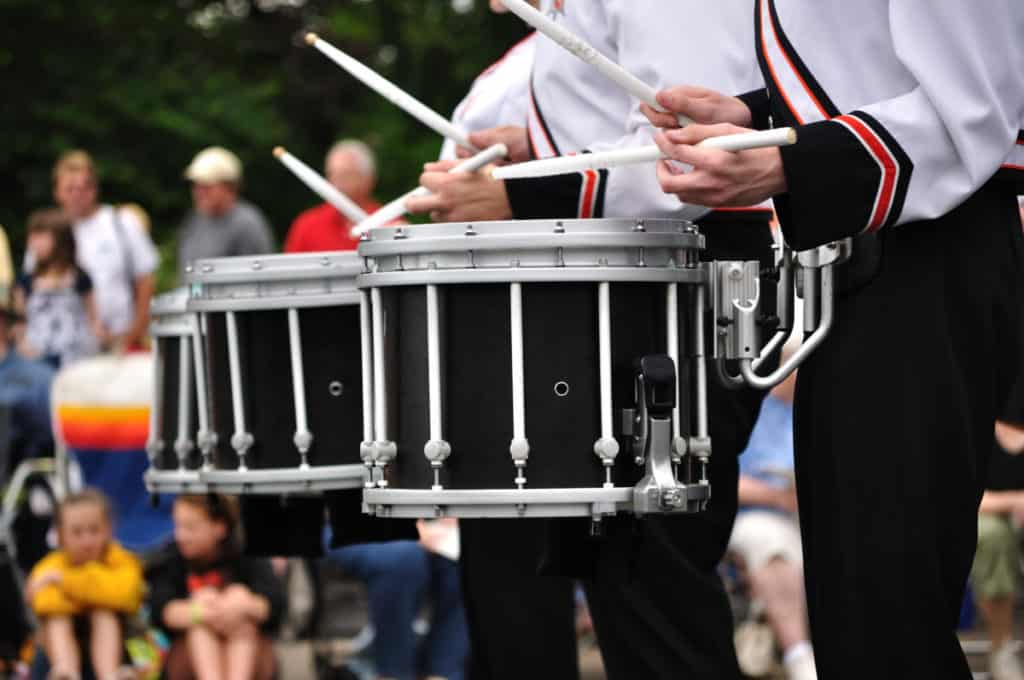
By the way, looking for recording equipment and musical instruments? Check out Sweetwater.com for microphones, monitors, audio interface or any other recording gear that you could ever need. (Affiliate Link)
That being said, there are many flavors of marching snares, and they vary in depth and diameter, and material. Most often they are made of wood with steel hardware.
Tenor Drums
Tenor drums appear in many respects very similar to snare drums but they sound very different for one big reason, they don’t have the metal wires that make that rattling sound. This allows the tenor drum to make a clear resonant tone. The interesting part about marching tenor drums is that they come in many different sizes and configurations.
Believe it or not, some of these tenor configurations can weigh over 40 lbs! (including the harness). To see what other marching drums weigh, check out our article here.
Single Tenors
Tenor drums can be carried … singly? I’m not sure how to describe that–but like a snare drum, in that they are carried one drum per person. The appearance of these tenor drums are similar to snares, with tough hardware made for harnesses and being lugged around. A single tenor drum comes in a variety of depths and sizes.
Single tenors look different than tenors in multiple configurations because of the way the tenor drum is balanced. A single tenor, for example, will have a flat bottom similar to a marching snare.
Quads
I played trumpet when I was in band and to tell you the truth, I didn’t realize that quads are not so much of a different type of drum–they are just a group of tenor drums in a quad configuration.
This picture illustrates what quads can look like:
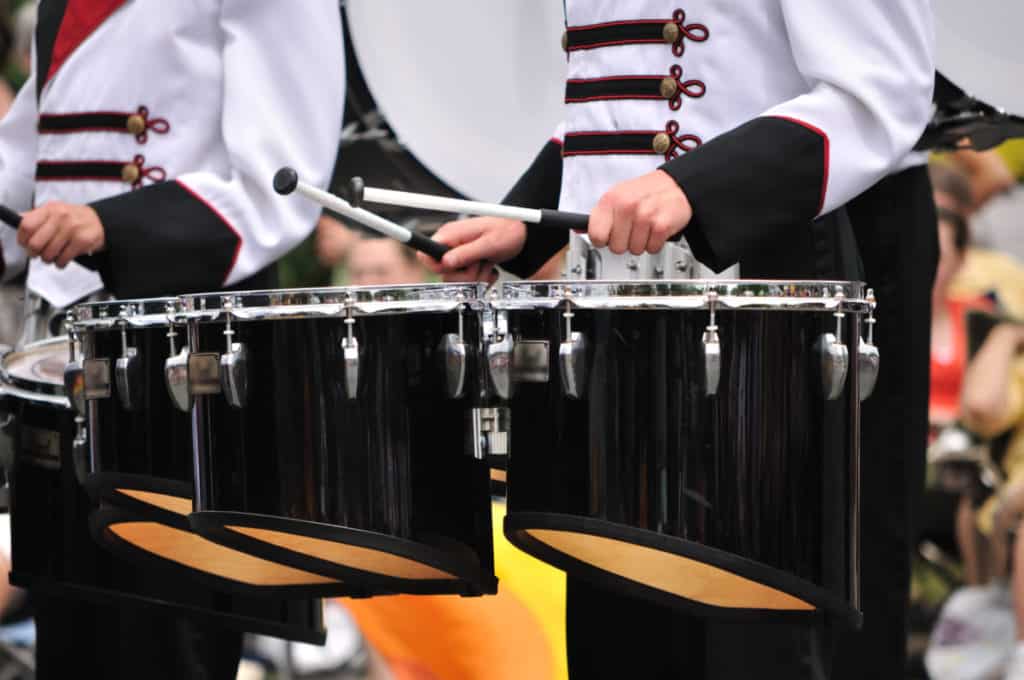
Notice that quads are sized, arranged, and cut differently than a single drum–often the quads are designed to be balanced in such a way to make them possible to be carried.
Quints/Squints
The tenor configurations go on! You can find tenor drum configurations in packs of 5 (sometimes called Quints), and even 6 (sometimes called squints or hexes). Sometimes cowbells or other accessories are added, making these some of the most heavy instruments on the field!
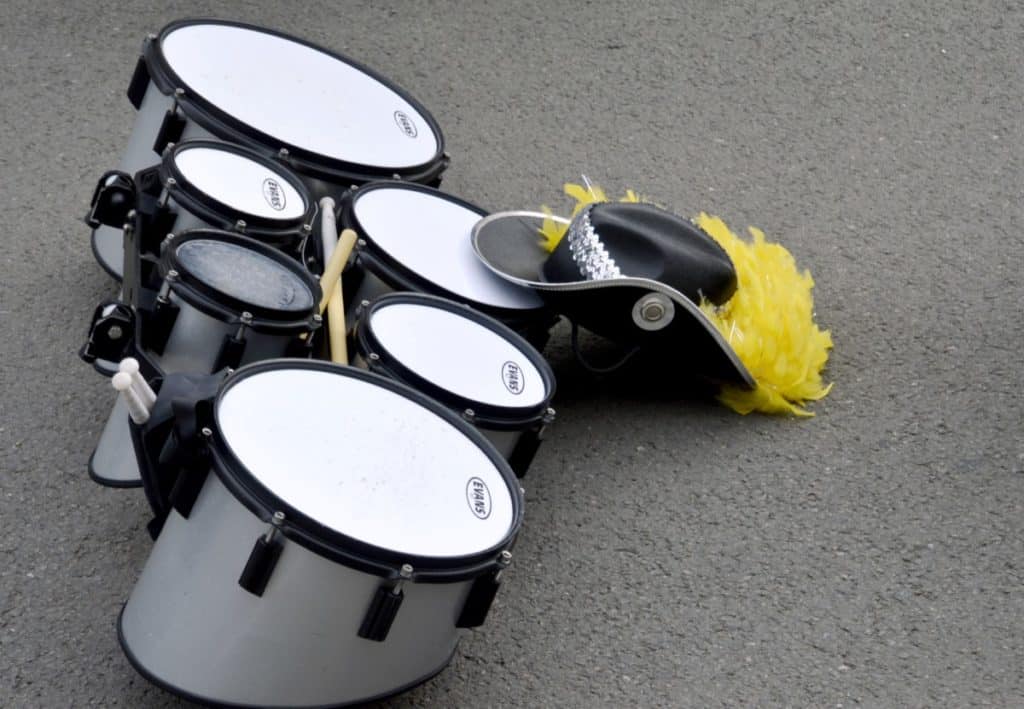
Bass Drum
I feel that a full drum ensemble would feel a little empty without the marching bass drum. Bass drums are incredibly important in marching bands because of the way sound travels.
Lower frequencies travel much better than higher frequencies–so marching bass drums are hugely important for balancing the sound of a band.
A marching bass drum is carried with the drumheads facing to the sides. They are also used with a harness, and can also come in various sizes. The bigger the person carrying the drum, the bigger the drum that can be carried (is often the mentality).
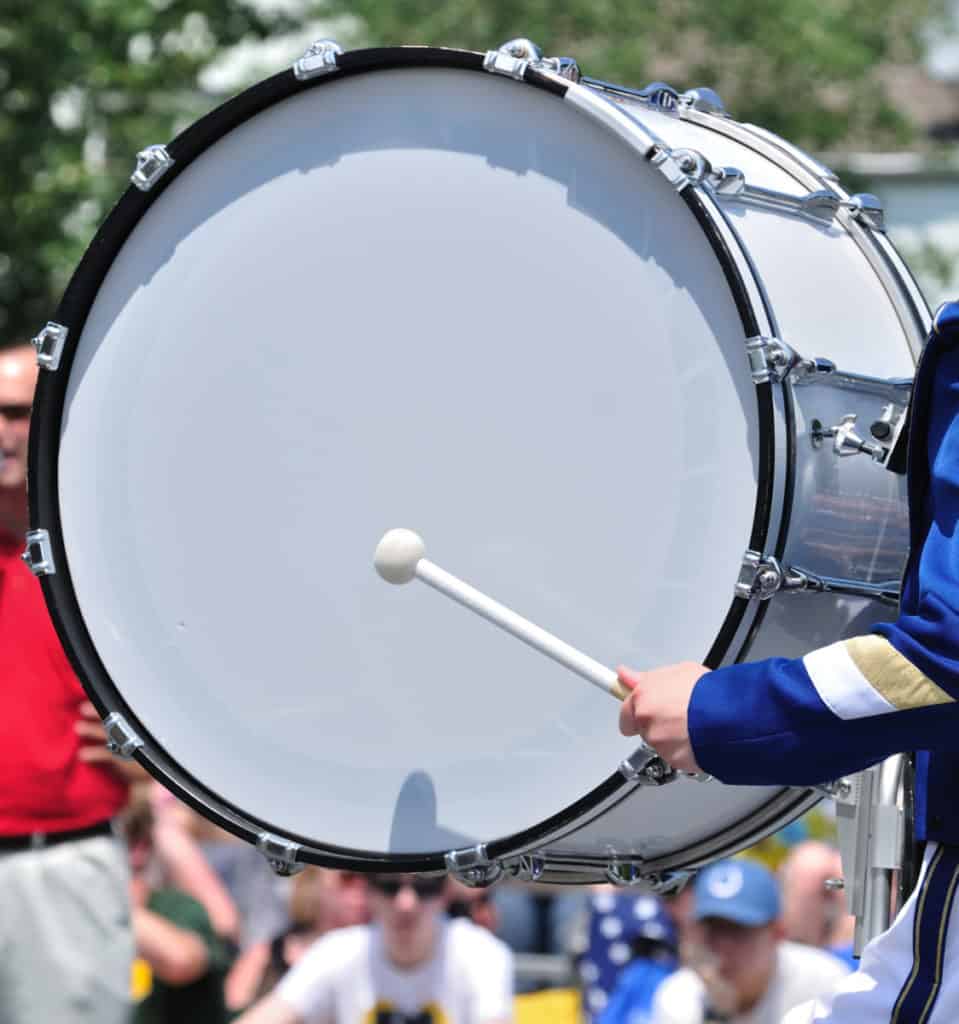
Timpani
Marching timpani are not as common to see, but they are occasionally used:
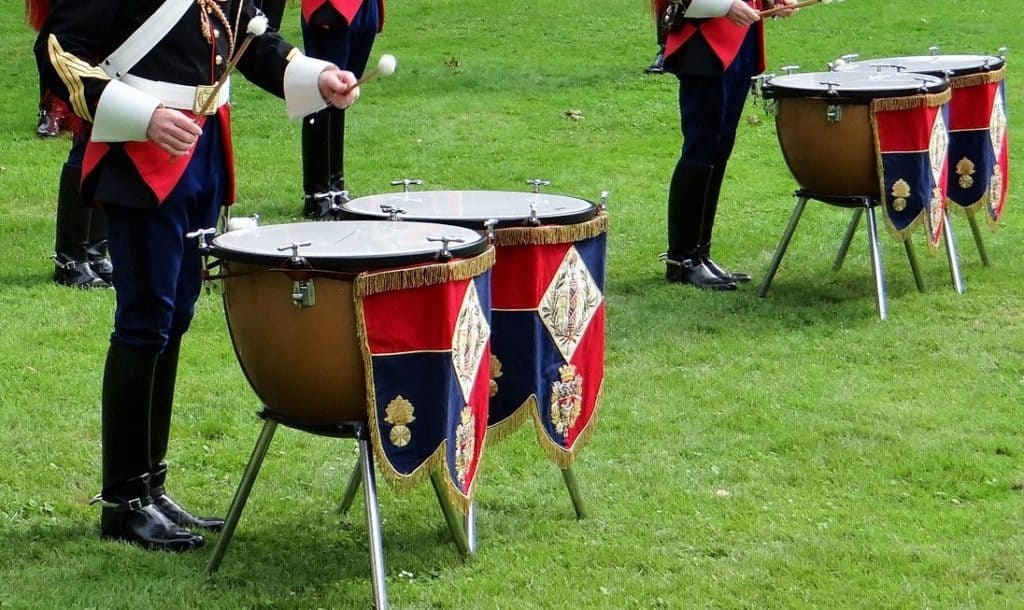
They are very different than the timpani you will see in an orchestra–the drum is much smaller and more compact than their orchestra counterparts.
Although at times you may see drumline timpani carried with a harness, it’s more common to see field timpani with small stands that allow the timpani to be played in the front rather than carried around the field.
Other Marching Drums
Often the only limiting factor on what type of instruments are carried onto the field is the imagination of the band director. Drums you don’t typically see in a marching band have been adapted for marching in some cases–such as the djembe, and the conga–both of which Pearl manufactures. (if you’re not sure what the difference between a djembe and a conga, check out our article here)
Marching Percussion
So–that’s just the drums. Now onto the percussion instruments!
Cymbals
In sit-down bands, cymbals are suspended by a stand and struck with a stick to make sound. With marching bands cymbals, the player strikes the cymbals with each other in a special way to make different types of sounds (crashes, sizzles, etc).
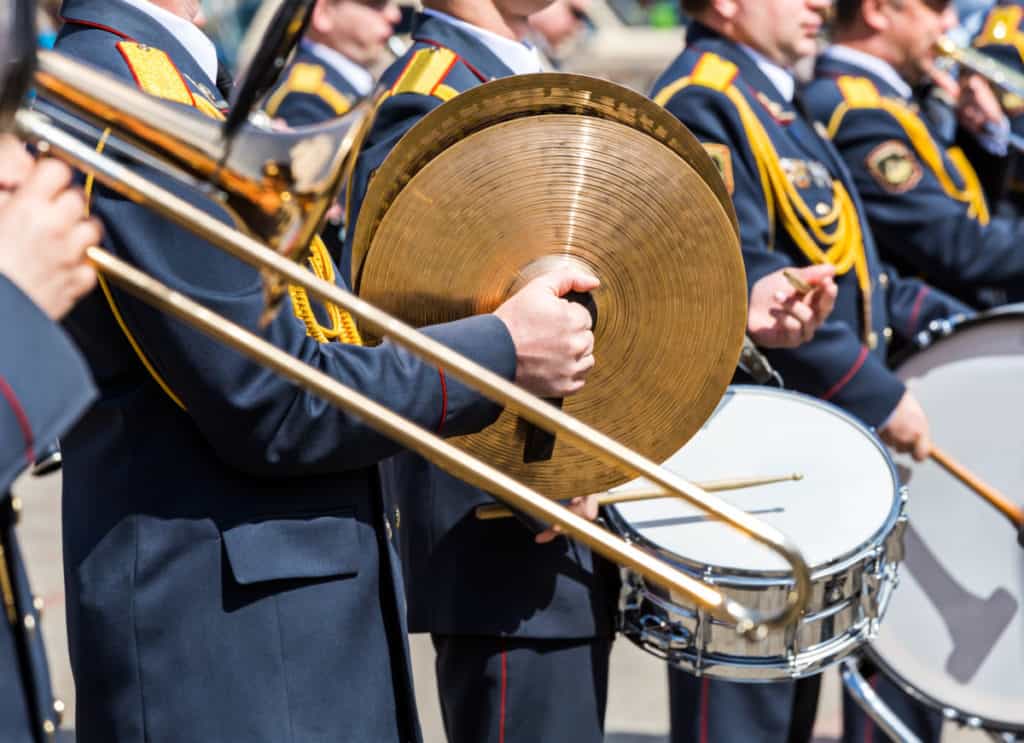
Marching band cymbals have straps that are connected to the crown of the cymbal in which the player grips the cymbal.
Glockenspiel/Bells
A marching glockenspiel (also called the bells) looks similar to what people call a xylophone but they are smaller and resonate incredibly. They have a kind of music box kind of sound and feel to them.
Marching bells are constructed in a way to allow for portability and can be carried and played with a harness. The instrument itself is struck with a mallet.
Bell Lyra
An interesting configuration for the bells is the Bell Lyra, and it looks similar to a gigantic lyre (kind of a harp), except instead of strings it uses bells.
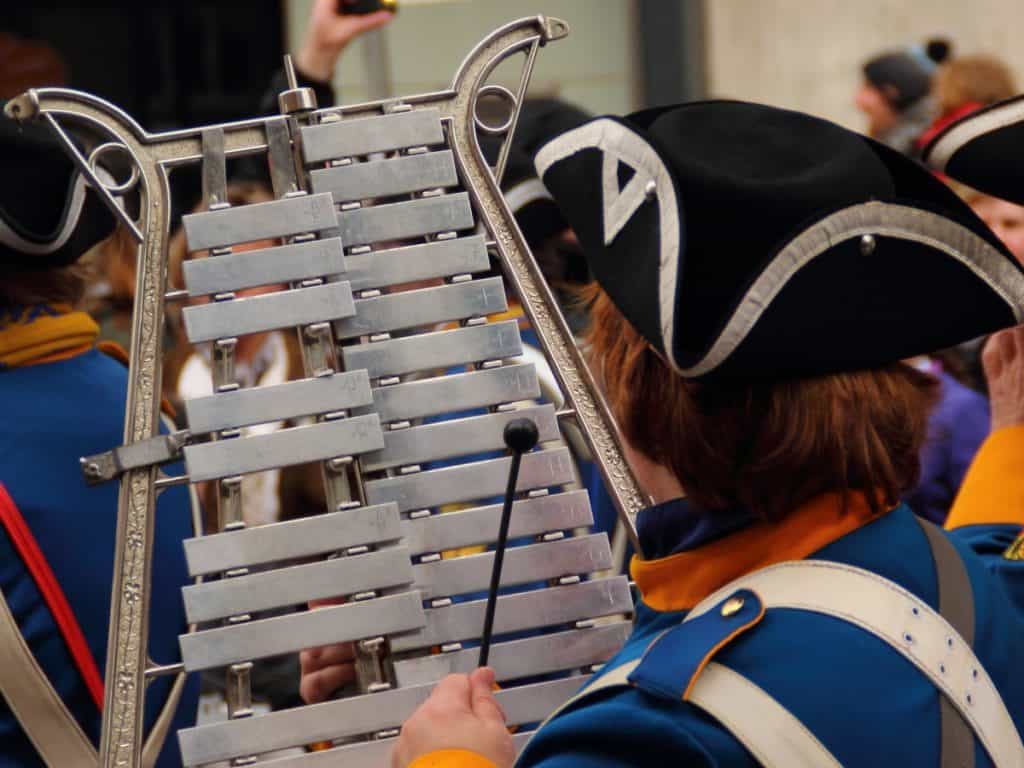
Xylophone/Marimba
Another contender in the mallet family is the xylophone or the marimba. Xylophones and marimbas have some key differences but are similar, especially their marching band varieties, where range and tone is sacrificed for compactness.
Some marching bands opt to not go for compact and instead keep these types of instruments in front.
Vibraphone
The vibraphone is a popular option because they often have built-in pickups allowing for easy amplification–always important for a marching band where there is only really one dynamic–LOUD! I am only kind of kidding.
The vibraphone is different than the xylophone or marimba in that it has a vibrato function that oscillates creating the characteristic wavy sound of the vibraphone.
Other Percussion
Marching band definitely doesn’t limit itself in the percussion department. You’ll see many, many other types of percussion being used. Some examples are:
- Chimes
- Marching Shakers (yes, that’s a thing)
- Cowbells
- Basically anything the band director wants on the field!
